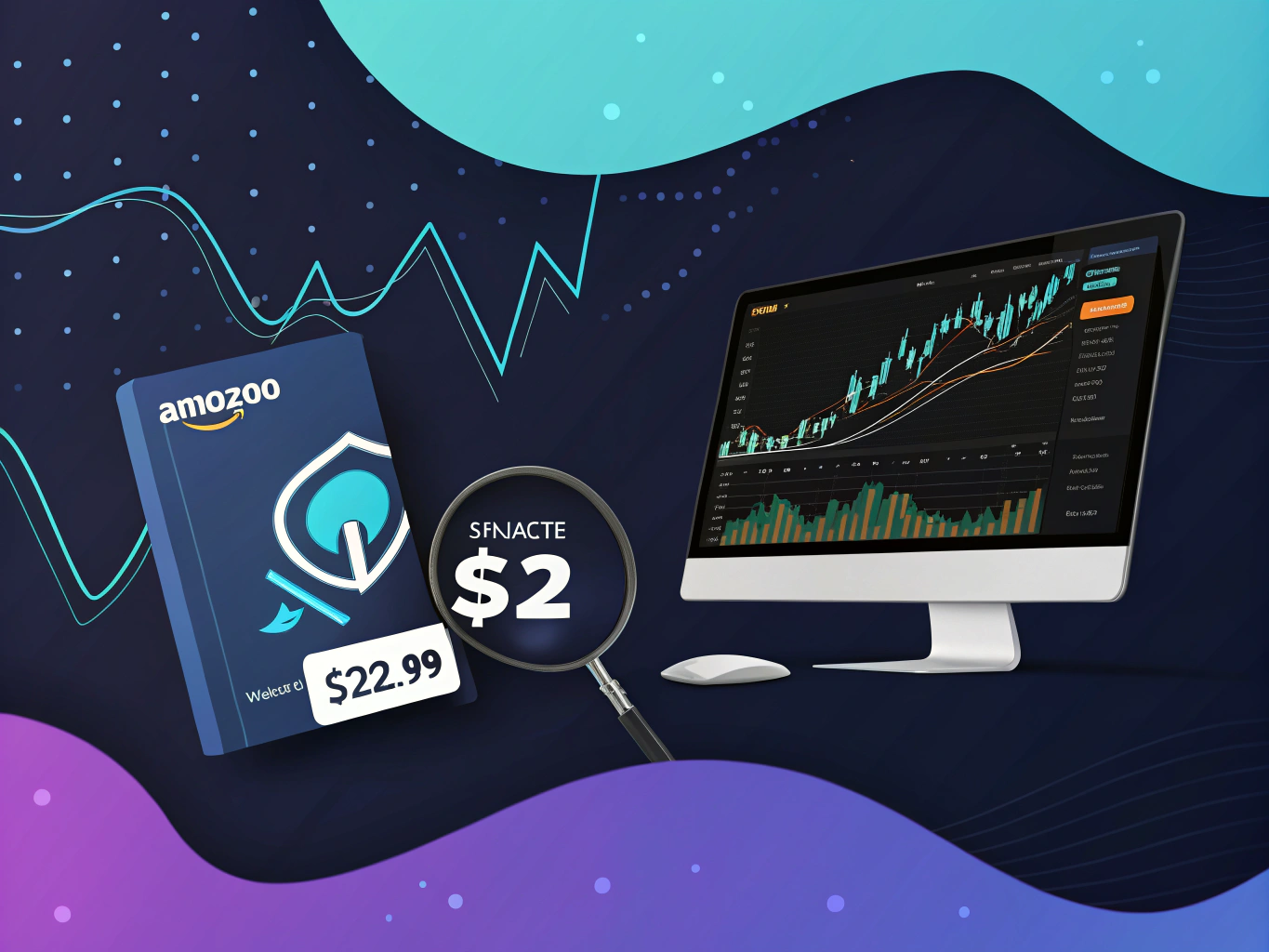Let’s address the elephant in the room: selling books on Amazon feels like trying to find a needle in a haystack while blindfolded. With over 48.5 million books listed on Amazon (last I checked), you might wonder if there’s even room for another author or publisher to squeeze in.

But here’s the thing – this massive marketplace isn’t actually your enemy. It’s more like a really complex game where most players are using outdated strategies from 2015 YouTube tutorials. And that’s exactly where your opportunity lies.
The Truth About How to Sell a Book on Amazon in 2025

I’ve spent the last decade watching Amazon transform from a simple marketplace into what I like to call “the everything algorithm.” And just like any algorithm, once you understand the rules, you can work with them instead of against them.
Think of Amazon’s book marketplace like a giant library where the librarian is actually a robot who speaks a very specific language. Learning this language isn’t just helpful – it’s essential for anyone wanting to sell a book on Amazon successfully.
Your Two Paths: Choose Your Own Adventure
Before we dive into the nitty-gritty, you need to make your first big decision. You’ve got two main routes to get your book on Amazon: traditional publishing and self-publishing through Amazon KDP (Kindle Direct Publishing). Both are valid, both can work, but they’re as different as New York and Los Angeles.
The Traditional Publishing Route
This is the path that probably first comes to mind when you think about publishing a book. You know the drill – find an agent, pitch to publishers, wait months (or years), and hope someone picks up your book. It’s like trying to get into an exclusive club where the bouncer is particularly picky.
If you go this route, your publisher will handle the Amazon logistics. But here’s what they don’t tell you: even with a traditional publisher, you’ll still need to understand Amazon’s ecosystem. Why? Because even the big publishing houses sometimes miss crucial optimization opportunities that could make or break your book’s success.
The Self-Publishing Revolution: Amazon KDP
Then there’s Amazon KDP – the path that’s revolutionized publishing so thoroughly that traditional publishers are still trying to catch up. It’s like having your own publishing house, except without the fancy office in Manhattan.
With KDP, you’re in control of everything: from your book’s price to its marketing strategy. It’s both liberating and terrifying, kind of like being handed the keys to a Ferrari when you’ve just learned to drive. But don’t worry – I’ll be your driving instructor.
Manuscript Preparation: The Secret Sauce
Now we’re getting to the part that makes or breaks your Amazon success. Your manuscript isn’t just a document anymore – it’s a product that needs to be optimized for Amazon’s ecosystem.
Formatting That Sells
I’ve seen brilliant books fail on Amazon simply because they were poorly formatted. The kindle kdp platform is particular about formatting, and for good reason. Your book needs to look professional across all devices, from the latest iPad Pro to a first-generation Kindle.
This is where tools like Kindle Create come in handy, but don’t let anyone tell you it’s the only option. I’ve seen authors create stunning books using everything from Adobe InDesign to Canva. The key isn’t the tool – it’s understanding Amazon’s requirements and meeting them consistently.
Setting Up Your Amazon Presence: More Than Just Clicking “Publish”

Before you can start selling your book on Amazon, you need to set up your presence correctly. This isn’t just about creating an account – it’s about building your digital storefront.
Creating Your Amazon KDP Account
First things first: head over to kdp.amazon.com and set up your account. This is pretty straightforward, but there are a few things most guides won’t tell you:
- Use your real name or official business name – Amazon’s verification process has gotten stricter
- Have your tax information ready – you’ll need it sooner than you think
- Set up your payment information immediately, even if you’re not ready to publish
Professional vs. Individual: Making the Right Choice
If you’re planning to sell physical books through Amazon’s marketplace (not just through KDP), you’ll need to decide between a Professional or Individual seller account. Here’s the real deal: Individual accounts are fine if you’re testing the waters, but Professional accounts give you access to better analytics and advertising tools.
The Setup Most People Get Wrong
Here’s where I see most authors stumble: they treat their Amazon presence like it’s just another social media profile. But your Amazon author page and seller account are more like a mini-website within Amazon’s ecosystem. They need the same attention to detail you’d give to your own website.
Think about it: when was the last time you bought a book from an author whose profile looked half-finished? Exactly. Your Amazon presence needs to be polished, professional, and complete before you even think about hitting that publish button.
The Nuts and Bolts of Amazon KDP
Setting up your KDP account is pretty straightforward – think of it as creating a really important social media profile. You’ll need the basics: your tax info, banking details, and a valid email address. But here’s where many authors trip up: they rush through the account setup without thinking about their long-term strategy.
Manuscript Magic: Preparing Your Book for Prime Time
Remember when I said AI is like an intern? Well, Amazon’s publishing system is like a very particular intern who needs everything just so. Your manuscript needs to meet specific formatting requirements, and trust me, this isn’t the place to get creative with your 8-point Comic Sans font.
For Kindle books, you’re looking at formats like .doc, .docx, or .epub. But here’s a pro tip that most guides won’t tell you: even if your formatting looks perfect in Word, preview it in the Kindle Previewer. I’ve seen too many authors skip this step only to find their beautiful chapter headings looking like they went through a digital blender.
Cover Design: Your Book’s First Impression
Look, I love DIY as much as the next entrepreneur, but your cover design is not the place to channel your inner kindergarten artist (unless you’re actually a professional designer). Think of your cover as your book’s Tinder profile – it needs to make people stop scrolling and click.
You’ve got options here:
– Use KDP’s Cover Creator (basic but functional)
– Hire a professional designer (recommended)
– Use design tools like Canva (middle ground)
– Commission custom artwork (if you’re feeling fancy)
The Money Talk: Pricing and Royalties
This is where things get juicy. Amazon’s royalty structure is like a game of strategy – you’ve got two main options: 35% or 70% royalties. But it’s not as simple as “70% is better.” Your choice affects your pricing flexibility and your international reach.
The 70% Royalty Option
Available for books priced between $2.99 and $9.99, this is the sweet spot for most authors. But there’s a catch – delivery costs get deducted from your royalties, and you need to enable Digital Rights Management (DRM). It’s like choosing the premium subscription plan – better benefits, but more rules to follow.
The 35% Royalty Option
This might seem like the short end of the stick, but it gives you more pricing flexibility. Want to price your book at $0.99 to build momentum? This is your path. It’s like running a sale at your store – sometimes lower margins lead to higher volume.
Print Book Pricing Strategy
For print books, your printing costs play a huge role in pricing. Amazon’s print on demand service means you don’t need to store inventory, but it also means higher per-unit costs. You’ll need to find that sweet spot between profitability and market expectations.
The Technical Stuff That Actually Matters

Here’s where we get into the nitty-gritty that separates the amateurs from the pros. Your ISBN (think of it as your book’s social security number) matters. For print books, you’ll need one. For ebooks, Amazon will give you a free ASIN (Amazon’s version of an ISBN).
And let’s talk about metadata – those behind-the-scenes details that help your book get discovered. Keywords, categories, and your book’s description aren’t just formalities. They’re your book’s SEO, and in the vast ocean of Amazon’s marketplace, good SEO is like having a lighthouse guiding readers to your shore.
Quality Control: The Make-or-Break Factor
Before you hit that publish button, run through this quality checklist:
– Professional editing completed
– Formatting checked across multiple devices
– Cover design meets Amazon’s specifications
– All metadata optimized
– Preview checked thoroughly
– Price point strategically set
Remember, publishing on Amazon isn’t just about getting your book out there – it’s about setting it up for success. And success in this game requires equal parts creativity and technical savvy. Think of it as building a digital storefront for your intellectual property – every detail matters.
Advanced Book Marketing Strategies on Amazon
Let’s be real – getting your book noticed on Amazon is like trying to make your voice heard at a packed Comic-Con panel. Everyone’s shouting, and you’re competing with both indie authors and the publishing giants. But here’s where it gets interesting: the playing field has never been more level.
Mastering Amazon’s Algorithm (Without Losing Your Mind)
Remember how Netflix somehow knows exactly what show you’ll binge-watch next? Amazon’s algorithm works similarly for books. It’s not magic – it’s math with a dash of behavioral psychology. The key is understanding how to work with it, not against it.
Your book’s success on Amazon KDP hinges on three critical factors: visibility, engagement, and conversion. Think of it like a three-act story structure – you need all parts working together.
How to Sell a Book on Amazon: The Marketing Deep Dive
First things first: your book’s Amazon page is your storefront. Just like you wouldn’t open a physical bookstore with dusty windows and dim lighting, your Amazon listing needs to shine. This means professional cover design, compelling book descriptions, and strategic keyword placement.
The Review Game: Playing it Smart
Reviews are the lifeblood of Amazon book sales, but here’s what most authors get wrong: they focus on quantity over quality. Instead of begging for reviews from anyone with a pulse, target readers who genuinely enjoy your genre. Use Kirkus Reviews if you want professional credibility – yes, it’s pricey, but it can be worth it for certain genres.
Amazon Advertising: Your Secret Weapon
Remember when I said the playing field was level? Amazon’s advertising platform is why. You can literally compete with Stephen King for reader attention – if you’re smart about it and leverage competitive intelligence tools to refine your strategies and outperform competitors. Start small, test different ad types, and track your ACoS (Advertising Cost of Sale) religiously.
Building Your Author Platform Beyond Amazon

Here’s something most guides won’t tell you: selling books on Amazon isn’t just about Amazon. Your success on the platform is heavily influenced by your presence elsewhere. Think of it like a tech ecosystem – each part strengthens the others.
Social Media: The Double-Edged Sword
Social media can be either your best friend or your biggest time-waster. The trick? Pick one platform where your readers actually hang out and master it, and don’t overlook tips for selling on Facebook Marketplace to diversify your audience reach. For fiction authors, Instagram and TikTok are gold mines. For non-fiction? LinkedIn and Twitter can be powerful allies.
Email Marketing: Your Most Valuable Asset
If social media is like casual dating, email marketing is marriage material. Build your list from day one. Every reader who joins your email list is worth their weight in gold – they’re not just buyers, they’re potential superfans who’ll pre-order your next book and leave those crucial early reviews.
The Long Game: Sustainable Success on Amazon
Look, I’ve seen too many authors treat their book launch like it’s a sprint when it’s really an ultra-marathon. Success on Amazon KDP publishing isn’t about gaming the system – it’s about building a sustainable author business.
Series Strategy: The Power of Multiple Books
Want to know a secret? The most successful authors on Amazon aren’t usually one-hit wonders. They’re methodically building a catalog. Each new book becomes a marketing tool for your others. It’s like compound interest for your author career.
Print on Demand: The Smart Author’s Choice
Amazon print on demand through KDP has revolutionized self-publishing. No more garage full of books. No more upfront printing costs. Just pure, beautiful efficiency. Use it wisely, and it can become a significant revenue stream alongside your ebooks.
Final Thoughts: Your Amazon Publishing Journey
Here’s the truth about selling books on Amazon in 2025: it’s both easier and harder than ever before. Easier because the tools and technology are there. Harder because, well, so is everyone else.
But here’s what matters: your success on Amazon isn’t determined by some mysterious algorithm or the whims of the publishing gods. It’s determined by your ability to write books people want to read, present them professionally, and market them effectively.
Remember that KDP Amazon account you set up? It’s not just a publishing platform – it’s your ticket to building a sustainable author business. Whether you’re writing fiction, non-fiction, or learning how to resell items on Amazon alongside creating coloring books, the principles remain the same: quality content, strategic marketing, and persistent execution.
The most successful authors I know aren’t necessarily the best writers – they’re the ones who treat their books like products and their writing like a business. They understand their market, respect their readers, and constantly learn and adapt.
So go forth and conquer the Amazon marketplace. But remember – like any good story, success rarely happens overnight. It’s built page by page, reader by reader, and book by book.
In addition to Amazon, consider exploring other platforms such as the Walmart affiliate program or learning from the eBay recently sold section. These can provide insights into customer preferences and emerging trends.
Finally, understanding the nuances of platforms like Shopify and engaging with communities such as eBay community can offer further opportunities for growth and collaboration.
By staying informed and adapting to changes, whether it’s comparing Caspa vs. Productscope, or leveraging new technologies, you’ll be well-equipped to navigate the evolving landscape of online book sales.
👉👉 Create Photos, Videos & Optimized Content in minutes 👈👈
Related Articles:
- Amazon Print on Demand: A Beginner’s Guide to Success
- Sell Digital Products on Amazon: A Beginner’s Blueprint
- Amazon Cross-Selling Methods: Ultimate Guide to Boost Sales
Frequently Asked Questions
How to sell a book on Amazon?
To sell a book on Amazon, you’ll need to set up a seller account on Amazon Kindle Direct Publishing (KDP). Once registered, you can upload your book’s manuscript and cover, set your pricing, and choose your distribution options. Amazon provides tools to help with formatting and cover design, and once everything is approved, your book will be available for purchase on the platform.
How to make a coloring book to sell on Amazon?
Creating a coloring book to sell on Amazon involves designing your pages using software like Adobe Illustrator or Canva to create intricate and appealing illustrations. After designing, you can compile these pages into a PDF file and upload it to Amazon KDP, where you can choose options for print quality and size. Ensure your designs are original and captivating to attract a wide audience.
How to write a book and sell it on Amazon?
Writing a book to sell on Amazon starts with choosing a topic you’re passionate about and conducting thorough research to bring depth to your writing. After writing and editing your manuscript, you can use Amazon KDP to publish your book, which involves formatting your manuscript for Kindle or print, designing a cover, and setting your pricing and distribution preferences. Once published, Amazon offers promotional tools to help you market your book.
How much does it cost to sell a book on Amazon?
Selling a book on Amazon through KDP is free, but Amazon takes a percentage of your sales, typically ranging from 30% to 70% depending on the royalty option you choose. There are no upfront costs to list your book, but you may incur costs for professional services like editing, cover design, and marketing if you choose to use them.
How to create a book on Canva to sell on Amazon?
Creating a book on Canva involves using its design tools to craft each page of your book, including the cover and interior illustrations or layouts. Once your book is designed, you can download it as a PDF suitable for print and upload it to Amazon KDP. Canva offers templates and design elements that can help you create professional-looking books ready for sale on Amazon.
About the Author
Vijay Jacob is the founder and chief contributing writer for ProductScope AI focused on storytelling in AI and tech. You can follow him on X and LinkedIn, and ProductScope AI on X and on LinkedIn.
We’re also building a powerful AI Studio for Brands & Creators to sell smarter and faster with AI. With PS Studio you can generate AI Images, AI Videos, Chat and Automate repeat writing with AI Agents that can produce content in your voice and tone all in one place. If you sell on Amazon you can even optimize your Amazon Product Listings or get unique customer insights with PS Optimize.
🎁 Limited time Bonus: I put together an exclusive welcome gift called the “Formula,” which includes all of my free checklists (from SEO to Image Design to content creation at scale), including the top AI agents, and ways to scale your brand & content strategy today. Sign up free to get 200 PS Studio credits on us, and as a bonus, you will receive the “formula” via email as a thank you for your time.
